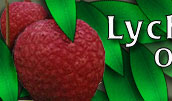15 Tips for Tips for Planting your Lychee Tree(s)
By William Mee & Krystal Folino
Location:
To grow a healthy lychee tree, start by planting it in a good location. Lychee trees need full sun so you should plant them away from other large trees and you should plant the trees at least 10 feet away from buildings. Shaded areas of the lychee canopy will generally not produce fruit so if you are planting the tree for it's future fruit production you should pay attention to your tree's level of sun exposure.
The new growth of lychee tree(s) is very delicate and easily damaged by the wind. Wind damage can severely impair the development of a small lychee tree and destroy new growth before it has a chance to develop and mature. Plant your tree in an area that receives some measure of wind protection.
Soil:
Lychee trees originated in the rainforests of southern China, where it is not unusual for trees to reach heights up to 100'. For best results, you should attempt to simulate the soil environment of the natural lychee habitat, which is rich in organic matter, moist with good drainage and free of artificial components like perlite or vermiculite.
A lychee tree will provide some natural organic matter to its soil zone through leaf and occasional branch litter and any fruit drop that occurs. However, you need to supplement the area above the root zone (slightly out past the drip line of the tree) with mulch and organic composts.
Mounding:
Do not mound the soil around tree(s), which is like growing your tree in a raised bed. While this may be fine for vegetables and certain other row crops it is not good for lychee tree(s): The root systems of air layered lychee trees are typically shallow and spreading, not much deeper that the height of the planting mound.
Mounding decreases the area through which lychee roots can grow and spread, it increases the exposed soil surface area that is subject to water loss and it exposes a cross section of the root zone to direct invasion by pathogens, such as fungi, nematodes and root damaging weevil. .
Fertilizer:
Use organic fertilizers that contain compost extracts, seaweed or kelp. Avoid using artificial fertilizers (Nitrogen, Phosphorus, Potassium) that will kill many of the essential organisms in the soil ecosystem of your lychee tree. NPK fertilizers, if misapplied (which is very easy) can burn your lychee tree(s) roots and cause soil particle aggregation, which, over time, negatively affects water drainage and impedes the microenvironments where essential soil food web organisms thrive. Fertilizer by products such as nitrates, sulfates and phosphates cause ground water contamination and regional environmental degradation and should not be used if there are alternatives.
Mycorrhizal Fungi:
Mychorrhizal fungi are a very important part of the soil food web and play a significant role in improving lychee tree root health and efficiency, especially in the natural mountain rainforest environments from which lychee trees originated. Fungi convert dead organic material into fungal biomass, carbon dioxide (CO2), and small molecules, such as organic acids. These fungi generally use complex substrates, such as the cellulose and lignin, in wood, and are essential in decomposing the carbon ring structures in some pollutants.
Mycorrhizal fungi enjoy a symbiotic relationship with lychee trees by feeding off of root exudates and providing the lychee tree(s) with a vastly improved transport system for water and soil nutrients through their extensive network of microtubules (hyphae). It is estimated that mycorrhizal fungi can increase the effective root system absorptive surface area by as much as 500%. You should apply (inoculate) mycorrhizal fungi to the root systems of your trees at the time of planting.
Earthworms:
Earthworms are the most important invertebrate member of the soil food web. They are major decomposers of dead and decomposing organic matter, and derive their nutrition from the bacteria and fungi that grow upon these materials. They fragment organic matter and make major contributions to recycling the nutrients it contains. Earthworms dramatically alter soil structure, water movement, nutrient dynamics, and plant growth
Earthworms stimulate microbial activity in the soil they tunnel through. They mix and aggregate the soil as they consume organic matter and they increase filtration through burrowing. Earthworm tunneling provides channels for root growth as they bury and shred plant residue pulled from surface material into their burrows.
The bottom line is that the presence of earthworms is a good visible indicator of a healthy soil. If you do not have earthworms you should add them to the soil surrounding your tree. If you do not already have an existing population of earthworms in the surrounding soil you can readily purchase them from any local bait and tackle shop.
Mulch:
Mulch is generally a mixture of decomposing organic material consisting primarily of chipped wood and shredded leaves. Mulch should be mixed with a good organic topsoil when planting lychee trees. Mycorrhizal fungi thrive on the woody component of mulch which consists of cellulose and lignin, compounds that are not readily decomposed by soil bacteria. You can obtain mulch from landscape maintenance companies or cities and counties which often have free mulch available from public lands.
Compost:
Typically, for most organic gardeners compost is a mixture of yard waste, leaf litter and food waste that has deteriorated to a rich earthy consistency. Compost provides a more readily available source of nitrogen than does mulch. Manure is an acceptable component of compost; however; care must be taken to insure that the manure has fully deteriorated. Raw manure will have the same negative effect as artificial NPK fertilizer that can damage soil food web organisms and burn your lychee trees' roots.
Foliar Phosphorus:
When lychee trees begin a new cycle of growth, following a period of dormancy, there is an increase in demand for cellular phosphorus. Phosphorus is a key component of the cellular energy transfer system (ATP and ADP) and is especially important during active cell division (mitosis and meiosis) which is the case when a tree puts out new growth. You can assist your tree by providing an external source of Phosphorus in the form of Phosphorous acid. This can be applied foliarly.
Plant Bananas as Windbreaks:
Bananas make an excellent, fast growing, windbreak. Their rotting fruit is a favorite of earthworms and the prolific amounts of leaf litter that they produce is an excellent source of enriching organic nutrients for the local soil food web. Bananas also provide shade for young lychee trees during the high temperature extremes encountered during sub-tropical summers.
When your lychee tree(s) become larger the bananas can become a nuisance, by providing too much shade for your lychee(s), but they are easily removed. If you choose to never remove the bananas and are actively involved in grove management, you can continuously cut off the new shoots that arise from the banana corms and spread this organic material around the base of your tree(s).
Squirrels are Lychee Pests:
These cute and highly adaptable tree dwelling rodents are a fun addition to any back yard, unless you have fruit trees. You forever will be in competition with squirrels for your fruit. Squirrels are great fans of lychees and they will plunder all of the fruit in your tree if this situation is allowed to go unchecked. They have a very annoying tendency whereby they take one or two bites out of the fruit and toss them on the ground, where they end up feeding the soil food web and not you.
You can hang "Just One Bite" in the canopy of your tree(s), being very careful to make sure that this peanut butter based rodenticide does not fall on the ground and tempt your household pets. This can be accomplished by wiring chunks of the bait into upper branches. On the other hand you can use "Hav-A-Hart" animal traps to catch squirrels and re-locate them to another more squirrel loving neighborhood.
No Understory Plants:
Avoid planting other plants beneath your lychee tree(s). Lychee trees, which are not grafter or seedlings, which describes most commercially produced trees, have spreading root systems that are close to the surface with no tap root. The roots of weeds and grasses and other plants growing on or around your lychee's roots will compete with your lychee tree for nutrients. The area under and around your lychee tree canopy has the highest root system density. You want all of the moisture and nutrients to get to the region around your lychee tree's roots (rhizosphere) and not be taken up by competitors.
Step Up the Container Size:
If you purchase a lychee tree from a nursery it typically will be planted in a 3 gallon or 10" diameter container. Make very sure that you water your tree every day as the water holding capacity of a 3 gallon container is very limited. One day without water in the hot afternoon sun is enough to de-hydrate your tree to the point where it may drop all of it's leaves.
The tree can live in this container for about a year if necessary; however, you should consider either planting the tree or stepping it up into a larger container sooner than later. Lychee trees will become root or pot bound if allowed to remain in the same size container for too long a period of time and this can lead to a decline in the health of your tree. The standard size progression of containers goes from 3 to 7 to 15 to 25 gallon.
When you step the tree up into a larger container you must take care to prepare the proper organic soil mix as well as inoculate the exposed roots with a mycorrhizal fungi. The soil mix should consist of equal parts of topsoil, compost and partially decomposed mulch with a visible woody component. A mix like this will provide good drainage while at the same time provide readily available nutrients for soil food web organisms. You should fertilize the tree growing in this mix with a good organic fertilizer such as a seaweed based compost broth or tea.
Planting Tips:
The best time to plant your lychee tree(s) is in the late Spring well after the risks of any frosts are over. If you are going to be relying on natural ainfall as the primary water supply for your lychee tree you should wait until the days of afternoon thunder showers begin. In Florida the coincides with the beginning of the rainy season which is in early to mid May. If you have irrigation available for your tree you can begin planting in late March and April. Water you tree in heavily and continue to water the newly planted tree every day until either the rains begin or you install or activate an existing automatic irrigation system.
Prune:
Strip off some of the excess foliage of your lychee tree to reduce the energy required to support the canopy and assist the root system while your lychee tree adjusts to it's new location. Stripping off foliage will induce bud break on the terminal branch ends that are stripped or pruned. This will develop into a growth flush and increase canopy density while the root system is developing.
Back To Lychee Info
|
|
|
Copyright © 1999-2010 Lychees Online
info@lycheesonline.com www.lycheesonline.com (954)648-6020
|

